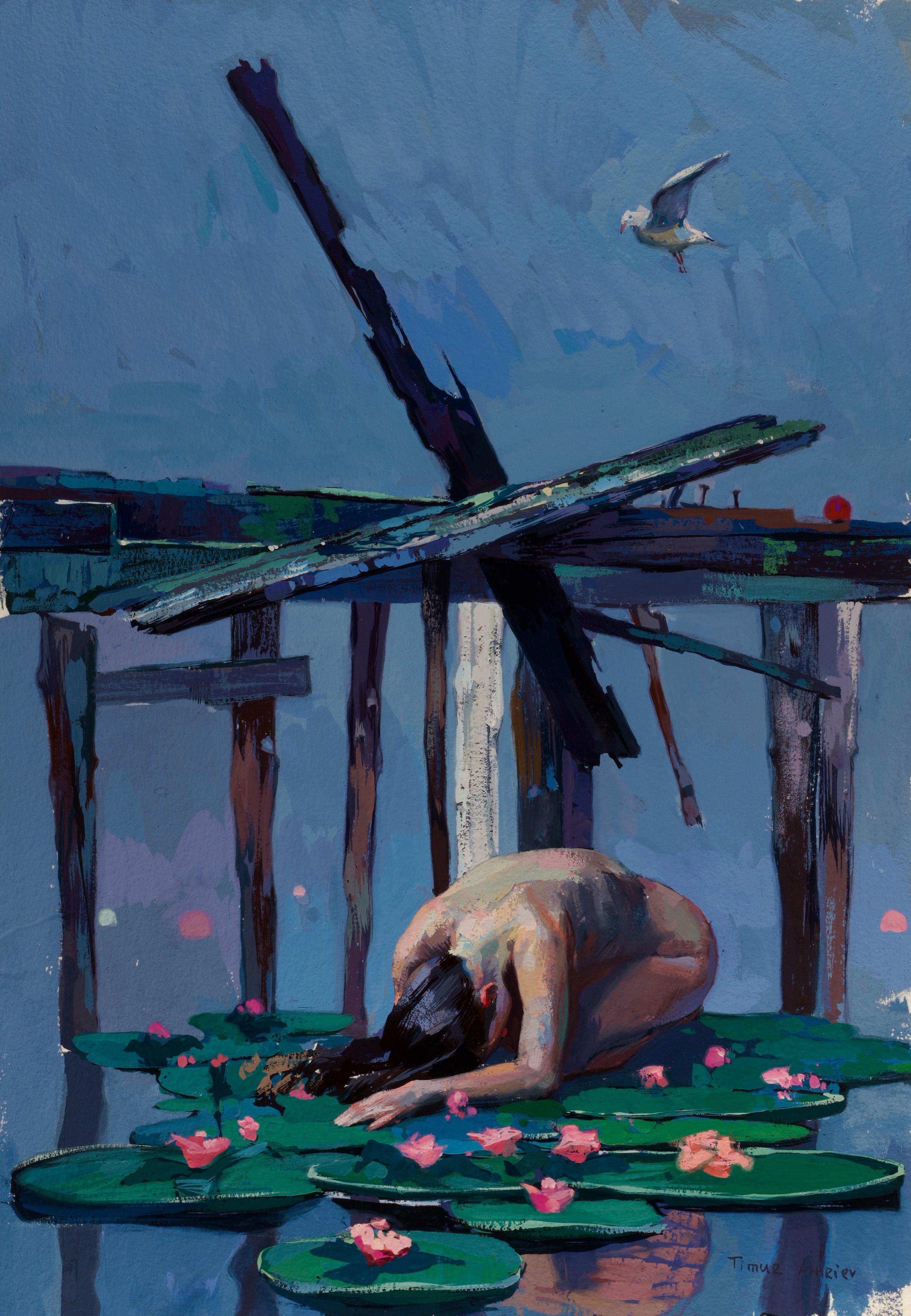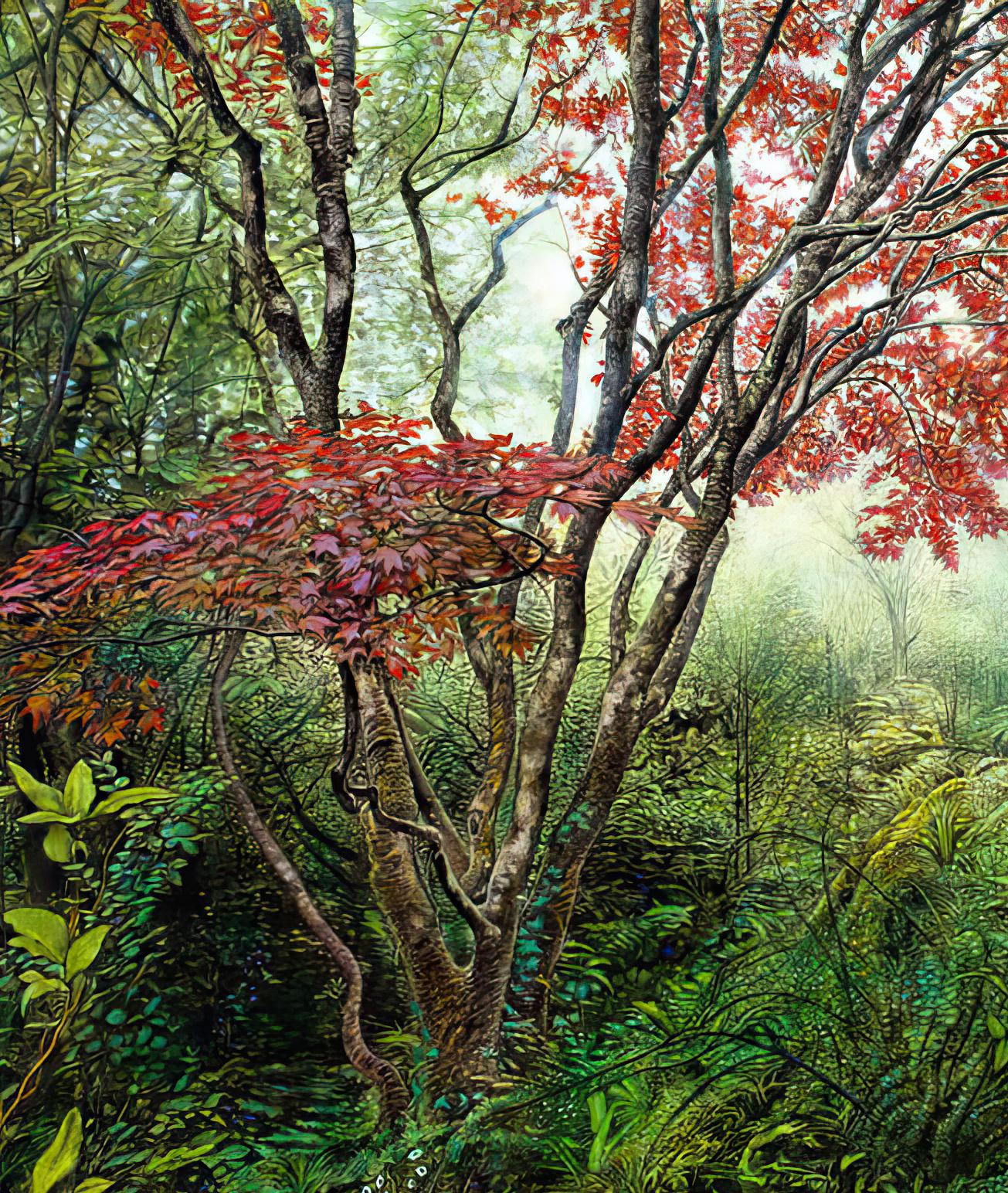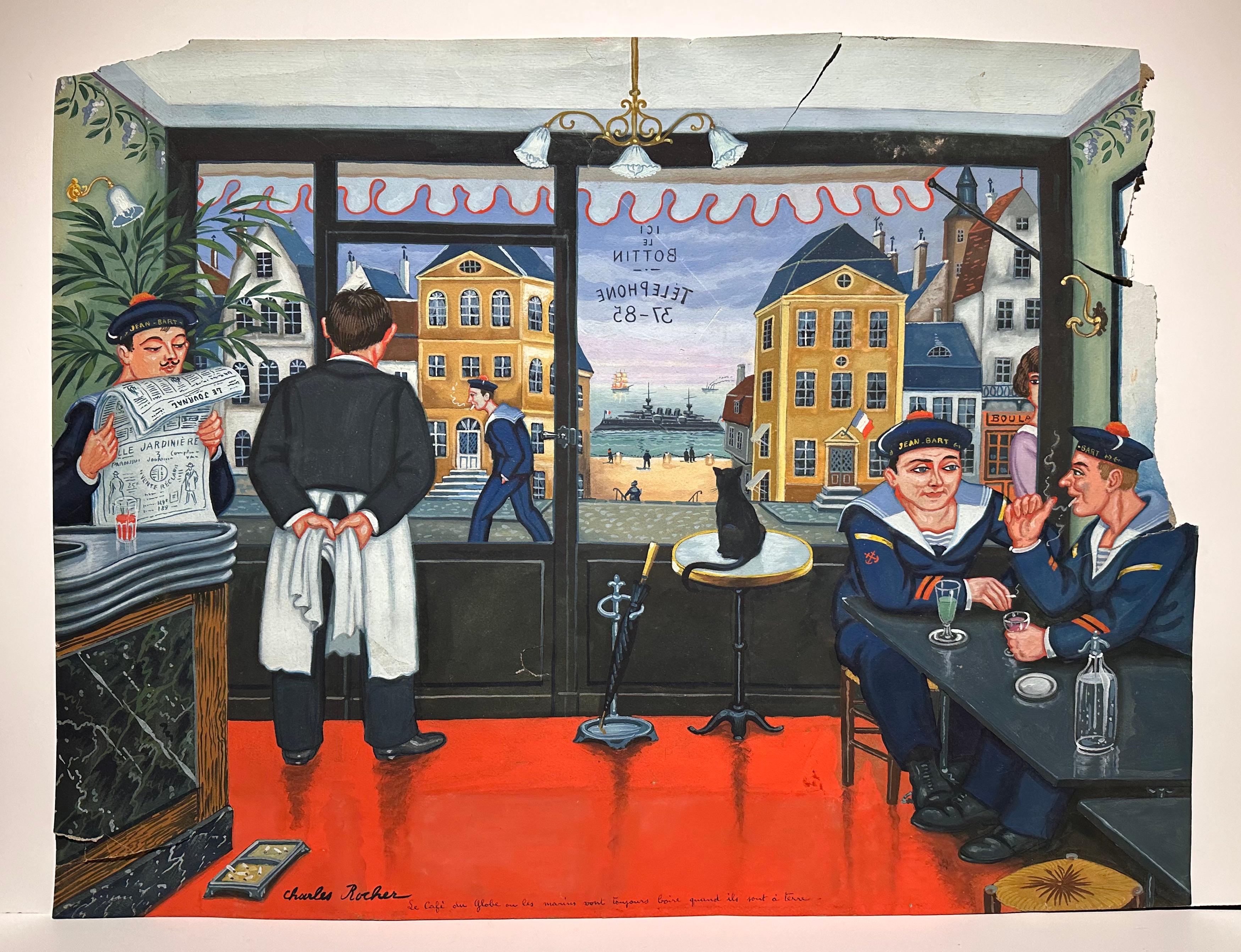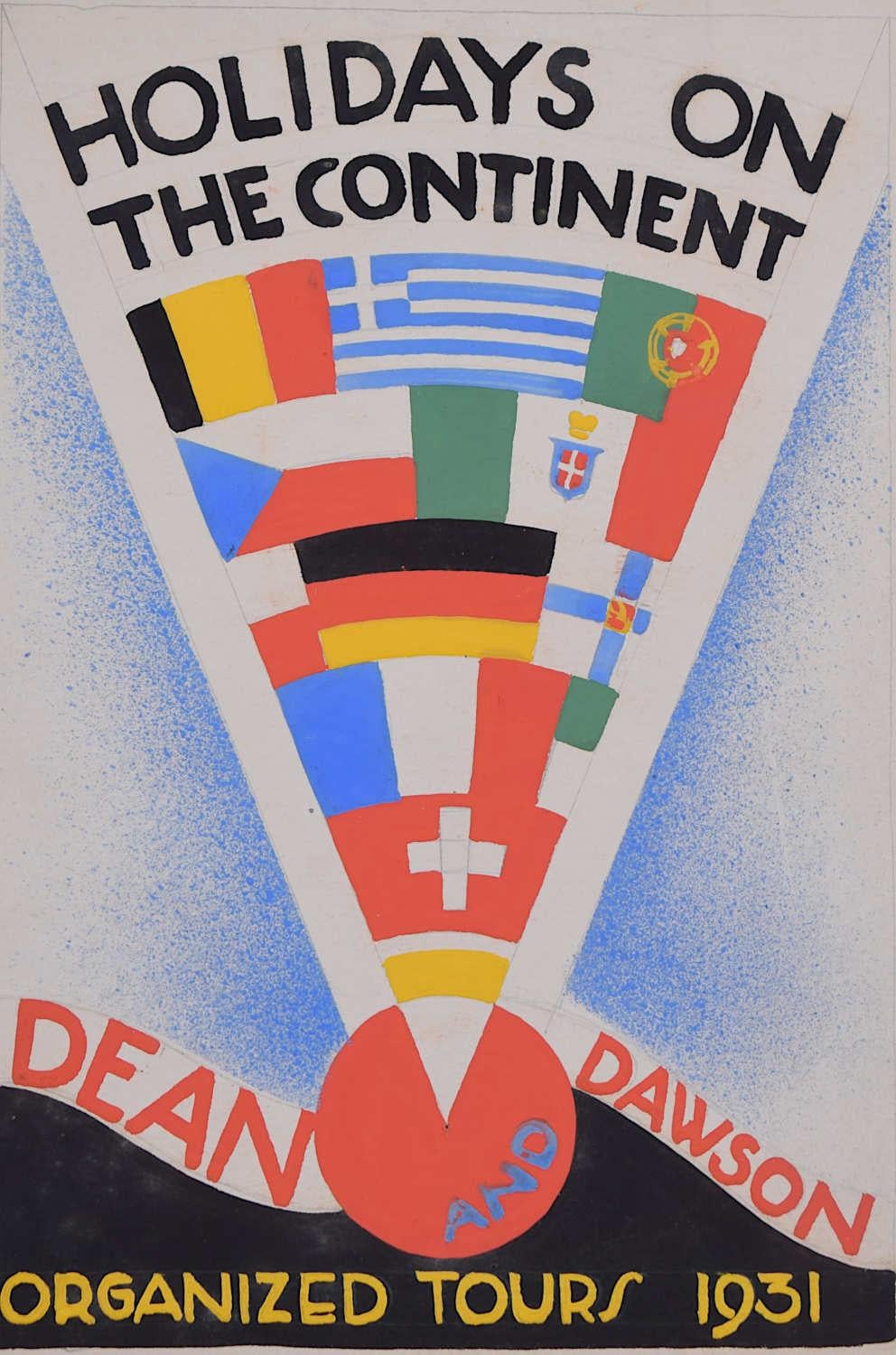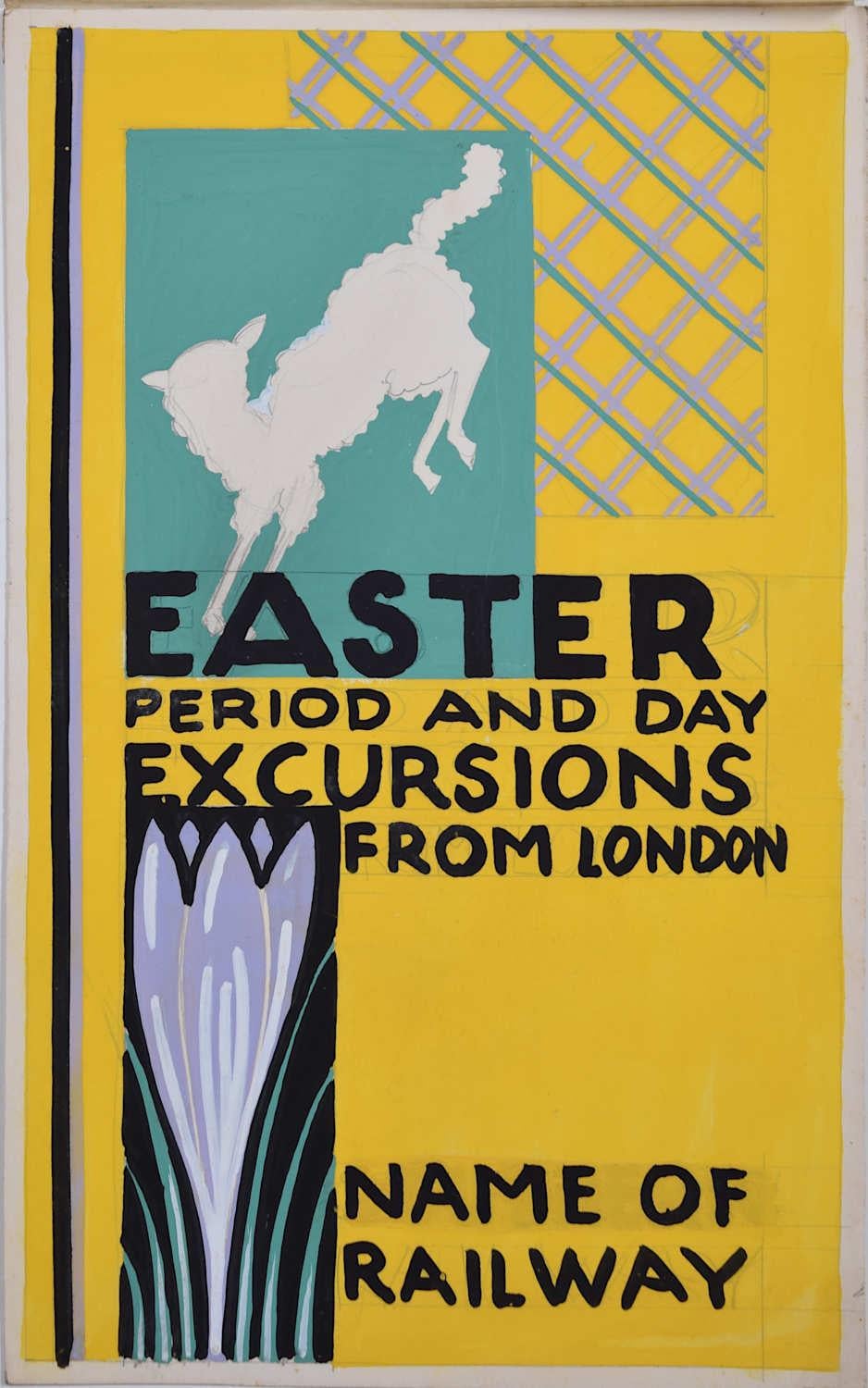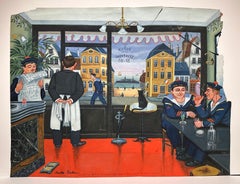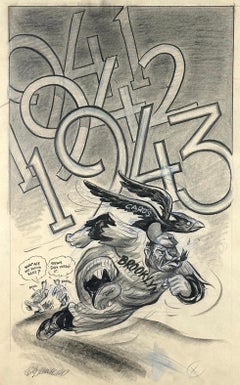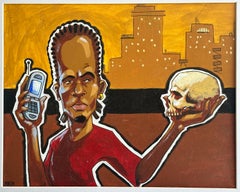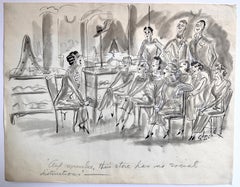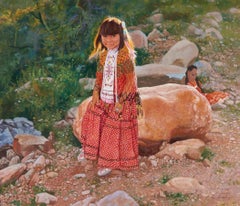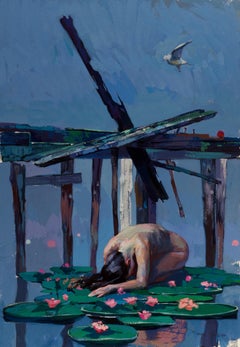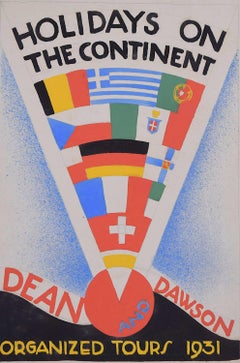Items Similar to Life Magazine Satirical Society Cartoon Illustration
Want more images or videos?
Request additional images or videos from the seller
1 of 13
BARBARA SHERMUNDLife Magazine Satirical Society Cartoon Illustration1940s
1940s
About the Item
Barbara Shermund (1899-1978). Society Satirical Cartoon, ca. 1940s. Gouache on heavy illustration paper, image measures 17 x 14 inches; 23 x 20 inches in matting. Signed lower left. Very good condition but matting panel should be replaced. Unframed.
Provenance: Ethel Maud Mott Herman, artist (1883-1984), West Orange NJ.
For two decades, she drew almost 600 cartoons for The New Yorker with female characters that commented on life with wit, intelligence and irony.
In the mid-1920s, Harold Ross, the founder of a new magazine called The New Yorker, was looking for cartoonists who could create sardonic, highbrow illustrations accompanied by witty captions that would function as social critiques.
He found that talent in Barbara Shermund.
For about two decades, until the 1940s, Shermund helped Ross and his first art editor, Rea Irvin, realize their vision by contributing almost 600 cartoons and sassy captions with a fresh, feminist voice.
Her cartoons commented on life with wit, intelligence and irony, using female characters who critiqued the patriarchy and celebrated speakeasies, cafes, spunky women and leisure. They spoke directly to flapper women of the era who defied convention with a new sense of political, social and economic independence.
“Shermund’s women spoke their minds about sex, marriage and society; smoked cigarettes and drank; and poked fun at everything in an era when it was not common to see young women doing so,” Caitlin A. McGurk wrote in 2020 for the Art Students League.
In one Shermund cartoon, published in The New Yorker in 1928, two forlorn women sit and chat on couches. “Yeah,” one says, “I guess the best thing to do is to just get married and forget about love.”
“While for many, the idea of a New Yorker cartoon conjures a highbrow, dry non sequitur — often more alienating than familiar — Shermund’s cartoons are the antithesis,” wrote McGurk, who is an associate curator and assistant professor at Ohio State University’s Billy Ireland Cartoon Library & Museum. “They are about human nature, relationships, youth and age.” (McGurk is writing a book about Shermund.
And yet by the 1940s and ’50s, as America’s postwar focus shifted to domestic life, Shermund’s feminist voice and cool critique of society fell out of vogue. Her last cartoon appeared in The New Yorker in 1944, and much of her life and career after that remains unclear. No major newspaper wrote about her death in 1978 — The New York Times was on strike then, along with The Daily News and The New York Post — and her ashes sat in a New Jersey funeral home for nearly 35 years until they were claimed by a descendant in search of information about her.
Barbara Shermund was born on June 26, 1899, in San Francisco. Her father, Henry Shermund, was an architect; her mother, Fredda Cool, a sculptor. Barbara displayed a knack for illustrating at a young age, and her parents encouraged her to explore her passion. She published her first cartoon when she was 8, in the children’s section of The San Francisco Chronicle.
Shermund’s mother died in 1918 in the Spanish flu pandemic. Some years later, her father married a woman 31 years his junior and eight years younger than Barbara. As her father and his new wife went on to build their own family, Barbara became estranged from them.
She attended the California School of Fine Arts (now the San Francisco Art Institute) to study printmaking and painting and regularly won awards.
She moved to New York City in her mid-20s to seek an independent life while pursuing her artistic ambitions, finding work creating cover art, cartoons and illustrations for magazines like Esquire, Life and Collier’s.
She is believed to have met Harold Ross and Rea Irvin through mutual connections from her studies and in the magazine industry. Her contributions to The New Yorker included about nine cover illustrations as well as spot illustrations and section mastheads that helped set the magazine’s visual tone.
Her perspective was influenced by her intersection with profound historical moments: In addition to surviving the Spanish flu pandemic, Shermund lived through World War I and the suffrage movement.
One of her cartoons from the 1920s, after women won the right to vote, depicted two men in tuxedos smoking by a grand fireplace, with one saying in the caption, “Well, I guess women are just human beings, after all.”
In 1943, Esquire magazine sent Shermund to the Hollywood set of the musical comedy “Du Barry Was a Lady” to sketch actresses performing in an I Love an Esquire Girl sequence. She created as well a promotional poster for the film, starring Red Skelton and Lucille Ball.
She also took on advertising commissions at a time when women were rare in that industry, illustrating ads for companies like Pepsi-Cola, Ponds, Philips 66 and Frigidaire.
From 1944 until about 1957, she produced Shermund’s Sallies, a syndicated cartoon panel for Pictorial Review, the arts and entertainment section of Hearst’s many Sunday newspaper.
Shermund lived out her last years drawing at her home in Sea Bright, N.J., and swimming at a beach nearby. She died on Sept. 9, 1978, at a nursing home in Middletown, N.J.
“The women she drew and the captions she wrote showed us women who were not afraid of making fun of men, and showed us what it was really like to be a woman,” Liza Donnelly, a cartoonist and writer at The New Yorker, said in an interview. “Shermund’s women had humor and guts, just like what I imagine the artist had herself.”
Perhaps one of Shermund’s most striking pieces is indicative of her irreverent and fearless spirit in life: A young girl sits on the lap of a paternal figure and says, “Please, tell me a story where the bad girl wins!”
About the Seller
4.9
Platinum Seller
Premium sellers with a 4.7+ rating and 24-hour response times
Established in 2007
1stDibs seller since 2015
397 sales on 1stDibs
Typical response time: 3 hours
- ShippingRetrieving quote...Shipping from: Wilton Manors, FL
- Return Policy
Authenticity Guarantee
In the unlikely event there’s an issue with an item’s authenticity, contact us within 1 year for a full refund. DetailsMoney-Back Guarantee
If your item is not as described, is damaged in transit, or does not arrive, contact us within 7 days for a full refund. Details24-Hour Cancellation
You have a 24-hour grace period in which to reconsider your purchase, with no questions asked.Vetted Professional Sellers
Our world-class sellers must adhere to strict standards for service and quality, maintaining the integrity of our listings.Price-Match Guarantee
If you find that a seller listed the same item for a lower price elsewhere, we’ll match it.Trusted Global Delivery
Our best-in-class carrier network provides specialized shipping options worldwide, including custom delivery.More From This Seller
View AllSailors at Cafe du Globe
By Charles Rocher
Located in Wilton Manors, FL
Charles Rocher (1890-1962. Sailors, ca. 1920s. Gouache on paper. Sheet measures 19 x 25 inches. Considerable damage and loss as depicted. Signed lower left.
Category
1920s Realist Figurative Paintings
Materials
Gouache
$560 Sale Price
20% Off
Same Old Story (Brooklyn Dodgers & St. Louis Cardinals Illustration)
Located in Wilton Manors, FL
Bill Crawford (1913-1982). Original illustration artwork depicting teams as they advance to the World Series. Depicted are representations of the St. Louis Cardinals and The Brooklyn...
Category
1940s Realist Figurative Paintings
Materials
Paper, Charcoal, Ink, Gouache, Pencil
Black Hamlet (Momento Mori) Cityscape
Located in Wilton Manors, FL
Beautiful painting depicts a young black man holding skull and flip phone. Gouache on illustration board, image measuring 8 x 10 inches; 16 x 20 inches framed. Signed lower left.
Category
Early 2000s Realist Figurative Paintings
Materials
Gouache, Illustration Board
Fancy Department Store Satirical Cartoon
Located in Wilton Manors, FL
Barbara Shermund (1899-1978). Fancy Department Store Satirical Cartoon, ca. 1930's. Ink, watercolor and gouache on heavy illustration paper, panel measures 19 x 15 inches. Signed lower right. Very good condition. Unframed.
Provenance: Ethel Maud Mott Herman, artist (1883-1984), West Orange NJ.
For two decades, she drew almost 600 cartoons for The New Yorker with female characters that commented on life with wit, intelligence and irony.
In the mid-1920s, Harold Ross, the founder of a new magazine called The New Yorker, was looking for cartoonists who could create sardonic, highbrow illustrations accompanied by witty captions that would function as social critiques.
He found that talent in Barbara Shermund.
For about two decades, until the 1940s, Shermund helped Ross and his first art editor, Rea Irvin, realize their vision by contributing almost 600 cartoons and sassy captions with a fresh, feminist voice.
Her cartoons commented on life with wit, intelligence and irony, using female characters who critiqued the patriarchy and celebrated speakeasies, cafes, spunky women and leisure. They spoke directly to flapper women of the era who defied convention with a new sense of political, social and economic independence.
“Shermund’s women spoke their minds about sex, marriage and society; smoked cigarettes and drank; and poked fun at everything in an era when it was not common to see young women doing so,” Caitlin A. McGurk wrote in 2020 for the Art Students League.
In one Shermund cartoon, published in The New Yorker in 1928, two forlorn women sit and chat on couches. “Yeah,” one says, “I guess the best thing to do is to just get married and forget about love.”
“While for many, the idea of a New Yorker cartoon conjures a highbrow, dry non sequitur — often more alienating than familiar — Shermund’s cartoons are the antithesis,” wrote McGurk, who is an associate curator and assistant professor at Ohio State University’s Billy Ireland Cartoon Library & Museum. “They are about human nature, relationships, youth and age.” (McGurk is writing a book about Shermund.
And yet by the 1940s and ’50s, as America’s postwar focus shifted to domestic life, Shermund’s feminist voice and cool critique of society fell out of vogue. Her last cartoon appeared in The New Yorker in 1944, and much of her life and career after that remains unclear. No major newspaper wrote about her death in 1978 — The New York Times was on strike then, along with The Daily News and The New York Post — and her ashes sat in a New Jersey funeral home...
Category
1930s Realist Figurative Paintings
Materials
Gouache, Ink
$1,875 Sale Price
25% Off
Broadway Costume Design Illustration
Located in Wilton Manors, FL
Fabulous illustration depicts a costume for Broadway production. Gouache on illustration board, image measures 10.5 x 16.5 inches; 15 x 22 inches framed.
Excellent condition in ori...
Category
1960s Realist Figurative Paintings
Materials
Gouache, Illustration Board
The Soda Fountain (New Yorker Magazine cover proposal)
Located in Wilton Manors, FL
Barbara Shermund (1899-1978). The Soda Fountain, ca. 1950s. Watercolor and ink on paper, 9 x 12 inches; 13 x 16 inches framed. Signed lower right. Exc...
Category
Mid-20th Century Realist Figurative Paintings
Materials
Ink, Watercolor
$2,000 Sale Price
33% Off
You May Also Like
"AFTER GLOW" NATIVE AMERICAN GIRL W/DOLL (1926-2019) Arizona / California
Located in San Antonio, TX
Don Crowley
(1926-2019)
Arizona / California Western Artist
Image Size: 11 x 13
Frame Size: 18 x 20
Medium: Gouache Study
"After Glow" Indian Girl with her...
Category
Early 1900s Realist Figurative Paintings
Materials
Gouache
"Worship" (2020) By Timur Akhriev, Original Realist Gouache Painting
By Timur Akhriev
Located in Denver, CO
Timur Akhriev's (US and EU based) "Worship" is an original, handmade oil painting that depicts a lone nude female figure kneeling on a bed of lily pads with pink flowers and bent over as if worshiping, with deteriorating structures in the background and a seagull flying overhead.
Born in Vladikavkaz, the territory where Southern Russia meets Chechnya in 1983, Timur lived with his family until moving from the region during the conflict of 1991. After moving to St. Petersburg Timur began attending the St. Petersburg Iagonson Fine Art School at the age of twelve, where many of the professors studied at the Repin Academy of Fine Arts.
After graduation in 2002, Timur immigrated to Chattanooga Tennessee...
Category
2010s Realist Portrait Paintings
Materials
Paper, Gouache
$650 Sale Price
45% Off
"The Long Way Home" (2019) By Thane Gorek, Original Gouache Landscape Painting
Located in Denver, CO
"The Long Way Home" by Thane Gorek (United States) is a handmade landscape oil painting that is framed and ready to hang.
Thane Gorek is an artist working in Northern Colorado. He s...
Category
21st Century and Contemporary Realist Figurative Paintings
Materials
Gouache
$2,850 Sale Price
28% Off
Holidays on the Continent, 1930s railway poster design by A. E. Halliwell
Located in London, GB
A. E. Halliwell (1905-1987)
Holidays on the Continent
Gouache
19 x 13 cm
Stamped to reverse, A E Halliwell Gunnersbury Gardens.
c.1930
Provenance: Family of the artist
A.E. Halliwel...
Category
1930s Realist Figurative Paintings
Materials
Gouache
Easter Excursions from London, 1930s railway poster design by A. E. Halliwell
Located in London, GB
A. E. Halliwell (1905-1987)
Easter Excursions from London
Gouache
26 x 15 cm
c.1930
Provenance: Family of the artist
A.E. Halliwell (1905–1986) was a British artist, illustrator, a...
Category
1930s Realist Figurative Paintings
Materials
Gouache
Early Summer Period Excursions from London, 1930s railway poster design
Located in London, GB
A. E. Halliwell (1905-1987)
Early Summer Period Excursions from London
Gouache
26 x 15 cm
c.1930
Provenance: Family of the artist
A.E. Halliwell (1905–1986) was a British artist, i...
Category
1930s Realist Figurative Paintings
Materials
Gouache
Recently Viewed
View AllMore Ways To Browse
Life Magazine Posters
Esquire Magazine
1940s Illustration
Vintage Illustration Children
Cartoon Illustration
1940s Paintings Women
New Yorker Cover
Society Lady Painting
Cartoon Poster
Vintage Cartoon Posters
Swimming Women
1940 American Sofa
Poster About Women
She Should Have Said No
Paintings 1940s Girl
1920s Beach Painting
1978 Couches
Painting Of Woman On Sofa

